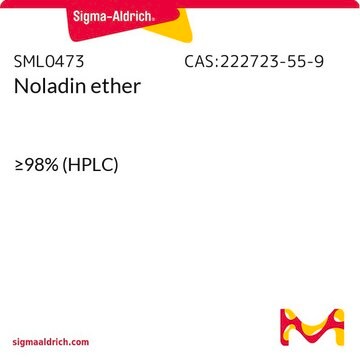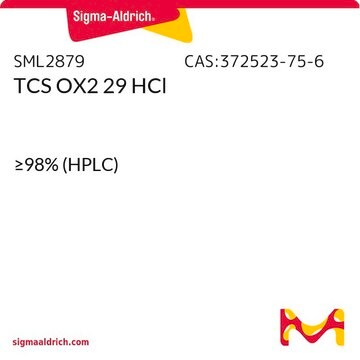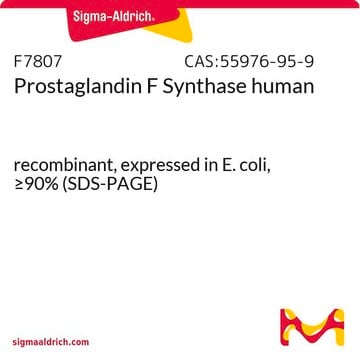SML2140
TCS 401
≥98% (HPLC)
Sinonimo/i:
2-[(Carboxycarbonyl)amino]-4,5,6,7-tetrahydrothieno[2,3-c]pyridine-3-carboxylic acid hydrochloride, TCS-401, TCS401
Autenticatiper visualizzare i prezzi riservati alla tua organizzazione & contrattuali
About This Item
Formula empirica (notazione di Hill):
C10H10N2O5S · xHCl
Numero CAS:
Peso molecolare:
270.26 (free base basis)
Codice UNSPSC:
12352200
NACRES:
NA.77
Prodotti consigliati
Saggio
≥98% (HPLC)
Forma fisica
powder
Colore
white to beige
Solubilità
0.1 M NaOH: 2 mg/mL, clear (warmed)
Temperatura di conservazione
2-8°C
Azioni biochim/fisiol
TCS 401 is a selective inhibitor of protein-tyrosine phosphatase 1B (PTP1B), which plays a key role in the negative regulation of the insulin signaling pathway, contributing to insulin resistance. It exhibited Ki values of 290 nM for PTP1B, with greater than 100-fold or more selectivity compared to other phosphatases. Inhibition of PTP1B by TCS 401 has been shown to sensitize the insulin signaling pathway and increase dopamine release in response to insulin. TCS-401 has also been shown to promote endothelial cell motility and to induce differentiation of retinal pigment epithelial cells toward improved contractility and motility.
Codice della classe di stoccaggio
11 - Combustible Solids
Classe di pericolosità dell'acqua (WGK)
WGK 3
Punto d’infiammabilità (°F)
Not applicable
Punto d’infiammabilità (°C)
Not applicable
Certificati d'analisi (COA)
Cerca il Certificati d'analisi (COA) digitando il numero di lotto/batch corrispondente. I numeri di lotto o di batch sono stampati sull'etichetta dei prodotti dopo la parola ‘Lotto’ o ‘Batch’.
Possiedi già questo prodotto?
I documenti relativi ai prodotti acquistati recentemente sono disponibili nell’Archivio dei documenti.
Steve C Fordahl et al.
ACS chemical neuroscience, 8(2), 290-299 (2016-12-15)
Systemically released insulin crosses the blood-brain barrier and binds to insulin receptors on several neural cell types, including dopaminergic neurons. Insulin has been shown to decrease dopamine neuron firing in the ventral tegmental area (VTA), but potentiate release and reuptake
L F Iversen et al.
The Journal of biological chemistry, 275(14), 10300-10307 (2000-04-01)
Several protein-tyrosine phosphatases (PTPs) have been proposed to act as negative regulators of insulin signaling. Recent studies have shown increased insulin sensitivity and resistance to obesity in PTP1B knockout mice, thus pointing to this enzyme as a potential drug target
Samuel Legeay et al.
Biomedicine & pharmacotherapy = Biomedecine & pharmacotherapie, 127, 110200-110200 (2020-05-18)
Diabetes notably increases the risk for endothelial dysfunction, a main precursor for microvascular complications. While endoplasmic reticulum stress (ERS) and protein tyrosine phosphatase 1B (PTP1B) have been associated with endothelial dysfunction in resistance vessels, whether these mechanisms also contribute to
Zhao-dong Du et al.
Molecular vision, 21, 523-531 (2015-05-23)
To determine whether protein tyrosine phosphatase 1B (PTP1B) is expressed in rat retinal pigment epithelium (RPE) cells, to evaluate whether inhibition of PTP1B contributes to initiation of RPE cells into an active state, and to investigate the signaling pathways involved
Il team dei nostri ricercatori vanta grande esperienza in tutte le aree della ricerca quali Life Science, scienza dei materiali, sintesi chimica, cromatografia, discipline analitiche, ecc..
Contatta l'Assistenza Tecnica.







